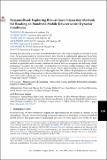Files in this item
DynamicRead : exploring robust gaze interaction methods for reading on handheld mobile devices under dynamic conditions
Item metadata
| dc.contributor.author | Lei, Yaxiong | |
| dc.contributor.author | Wang, Yuheng | |
| dc.contributor.author | Caslin, Tyler | |
| dc.contributor.author | Wisowaty, Alexander | |
| dc.contributor.author | Zhu, Xu | |
| dc.contributor.author | Khamis, Mohamed | |
| dc.contributor.author | Ye, Juan | |
| dc.date.accessioned | 2023-05-25T14:30:05Z | |
| dc.date.available | 2023-05-25T14:30:05Z | |
| dc.date.issued | 2023-05-18 | |
| dc.identifier | 286260006 | |
| dc.identifier | 9f1ddf19-dbdd-4026-9288-c6027f404cdc | |
| dc.identifier | 85160424436 | |
| dc.identifier.citation | Lei , Y , Wang , Y , Caslin , T , Wisowaty , A , Zhu , X , Khamis , M & Ye , J 2023 , ' DynamicRead : exploring robust gaze interaction methods for reading on handheld mobile devices under dynamic conditions ' , Proceedings of the ACM on Human-Computer Interaction , vol. 7 , no. ETRA , 158 . https://doi.org/10.1145/3591127 | en |
| dc.identifier.issn | 2573-0142 | |
| dc.identifier.other | ORCID: /0000-0002-0697-7942/work/135388094 | |
| dc.identifier.other | ORCID: /0000-0002-2838-6836/work/135455079 | |
| dc.identifier.uri | https://hdl.handle.net/10023/27675 | |
| dc.description | Funding: Lei, Y. and Wang, Y. acknowledge the financial support by the University of St Andrews and China Scholarship Council Joint Scholarship | en |
| dc.description.abstract | Enabling gaze interaction in real-time on handheld mobile devices has attracted significant attention in recent years. An increasing number of research projects have focused on sophisticated appearance-based deep learning models to enhance the precision of gaze estimation on smartphones. This inspires important research questions, including how the gaze can be used in a real-time application, and what type of gaze interaction methods are preferable under dynamic conditions in terms of both user acceptance and delivering reliable performance. To address these questions, we design four types of gaze scrolling techniques: three explicit technique based on Gaze Gesture, Dwell time, and Pursuit; and one implicit technique based on reading speed to support touch-free, page-scrolling on a reading application. We conduct a 20-participant user study under both sitting and walking settings and our results reveal that Gaze Gesture and Dwell time-based interfaces are more robust while walking and Gaze Gesture has achieved consistently good scores on usability while not causing high cognitive workload. | |
| dc.format.extent | 17 | |
| dc.format.extent | 5322606 | |
| dc.language.iso | eng | |
| dc.relation.ispartof | Proceedings of the ACM on Human-Computer Interaction | en |
| dc.subject | Eye Tracking | en |
| dc.subject | Mobile devices | en |
| dc.subject | Smartphones | en |
| dc.subject | Gaze-based Interaction | en |
| dc.subject | Dwell | en |
| dc.subject | Pursuit | en |
| dc.subject | Gaze Gesture | en |
| dc.subject | Scrolling Techniques | en |
| dc.subject | Reading | en |
| dc.subject | QA75 Electronic computers. Computer science | en |
| dc.subject | 3rd-DAS | en |
| dc.subject | MCC | en |
| dc.subject | AC | en |
| dc.subject.lcc | QA75 | en |
| dc.title | DynamicRead : exploring robust gaze interaction methods for reading on handheld mobile devices under dynamic conditions | en |
| dc.type | Journal article | en |
| dc.contributor.institution | University of St Andrews. School of Computer Science | en |
| dc.contributor.institution | University of St Andrews. Statistics | en |
| dc.identifier.doi | https://doi.org/10.1145/3591127 | |
| dc.description.status | Peer reviewed | en |
This item appears in the following Collection(s)
Items in the St Andrews Research Repository are protected by copyright, with all rights reserved, unless otherwise indicated.

